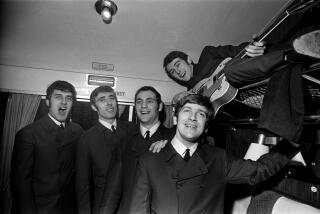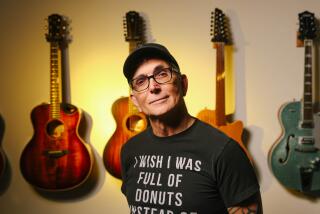POP MUSIC REVIEW : Out of Foggy Time Warp Appear the Moody Blues
- Share via
IRVINE — It started with a synthesizer droning through the darkness.
Then the fog machine kicked on. And the groovy light show began. The air filled with smoke, colors and a pseudo-classical tune. A group of old guys with long hair and nice clothes and instruments walked on stage to an uproarious welcome and played a predictable old-time favorite.
No, this wasn’t Spinal Tap. This was the Moody Blues, at the Bren Events Center Sunday night.
And they were serious.
Per usual, they began by greeting their audience through the colorful haze with “Lucky to See You Again.” Per usual, they played it safely and happily--almost exactly like it sounded on record all those years ago, crisp and clean, no rules broken, no messy risk of spontaneity.
Through two hour-long segments divided by a half-hour breather, the Moodys played all the hits, just like you remembered them from way back when: “Tuesday Afternoon,” “I’m Just a Singer (In a Rock and Roll Band),” “Nights in White Satin,” “Question” and, for the encore, “Ride My See-Saw.” Per usual.
A Moodys rock-block, right here on stage. Don’t touch that dial.
Actually, after 25 years that produced a wad of huge hits but few great songs, these Brits simply may be incapable of putting any fresh twists to their old concert staples. And, in any case, undeniably, the Moodys were delivering precisely what their fans wanted.
The faithful in the audience--mostly well over 30, conservatively clad and stuck in the ‘70s--gobbled everything up. About one-fifth of the seats were empty, but the screaming devotees made the place sound like a crowd had been squeezed into the aisles.
Given the circumstances, the band’s live approach is probably wise: Play the hit parade with no surprises, toss in a few new songs (though the band hardly has had a fresh idea since before classic rock radio was invented, it does continue to put out a new record every few years), graciously thank the audience, and collect that money.
Play them all, and above all, play it safe.
Actually, the Moodys were able Sunday to dish up their music without making it sound too warmed over. They may not be adding anything to the old songs, but neither are they detracting from them, which--sadly--is more than can be said about some other bands, even much younger ones, surviving on the glories of aulde.
Many of the original punk bands--who once sought to extinguish groups such as the Moodys from the face of the planet--still are plugging away but have dissolved into hapless self-parodies. The Moodys (who were joined by an extra drummer and keyboard player and two matching female backup singers choreographed in sync down to the blinking of their eyes) may have been blase, bland and oh-so predictable Sunday night, but rarely were they caricatures of their former selves.
On the contrary, they were doing the same thing they’ve always done, and though there certainly are much more interesting things going on in music today, you could take this or leave it for what it was and is.
The key to such success, however limited, may be Justin Hayward, the group’s guitarist and lead singer, who remains something of a stage presence to be reckoned with--because, ironically, he simply plays and sings, unlike flutist Ray Thomas and bassist John Lodge, who opt for stilted gestures and antics.
Hayward’s voice still is as ethereal and crystalline as it was when he introduced “Nights in White Satin” in 1967, and it was he who supplied the only (albeit mild) surprise of the show: Opening the second segment, he took the stage backed only by keyboards and sang “Forever Autumn,” an obscure track from the “War of the Worlds” LP he recorded with Jeff Wayne 15 years ago.
The rest of the Moodys might do well to follow Hayward’s bare-bones approach and drop the mega-concert trappings. Perhaps the band--conscious that very little is happening on stage musically--thinks it needs the incessant smoke machine, strobe lights and pretty projected laser patterns to fill in the blanks. In fact, they only make things worse.
Then again, judging by the reactions they provoked, these are what the audience came to see. And far be it from the Moody Blues to stray from the expected course.
More to Read
The biggest entertainment stories
Get our big stories about Hollywood, film, television, music, arts, culture and more right in your inbox as soon as they publish.
You may occasionally receive promotional content from the Los Angeles Times.










